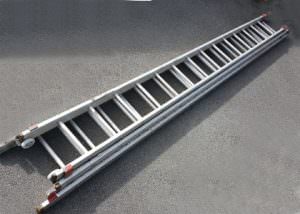This post isn’t about ladders

This weekend, I took delivery of a set of 11m, triple-extension, rope-operated ladders. New, they’re over £800, but I bought them for the bargain prices of £65! (By the way, this post isn’t about ladders, it’s about self assessment.)
So why only £65, you’re asking – well that’s certainly what I was asking.. Because they are ‘rope-operated’, each tier of the ladder runs in a groove in the one below, and it turned out that the top tier was pretty much stuck fast – certainly too dangerous to use, and probably the reason the previous owner wanted rid.
To try to make the ladder run freely, the previous owner had applied lashings of grease to the groove – a logical move, you might think – but this is the point at which we move from this post being about ‘ladders’ to the wonderful subject of self assessment – and the biggest mistake many providers make with quality improvement.
You see, he didn’t stop to find out what the root-cause issue was. He jumped straight to a solution.
Whenever providers do this (or anyone, as you can see), it’s pretty much odds on that they will fail to resolve the adverse symptom – in this case, a sticking ladder, but it could equally well be poor retention rates, poor attendance, poor levels of curiosity, etc.. Worse still, jumping to solutions too early so often makes the situation worse.
In this instance, the grease attracted so much dirt that it acted like a glue – at which point I’m convinced he decided to sell. When I eventually got the ladders apart and cleaned out all of the mess, the ladders still didn’t run freely. After a thorough investigation, I found that a rung near the top had taken a little knock and pushed the ladders’ sides out by just a millimetre or two, causing them to bind on two little ‘lugs’ that kept the ladder running true. Just two minutes after discovering the root-cause issue and addressing it with the correct reparatory action (a file) – well, you can imagine my delight.
So here’s the point: if you invest in finding the root-cause issues behind your adverse symptoms, corrective action is cheap. More importantly, however, it bolsters staff’s attitude towards quality improvement generally, making self assessment one of the most valuable parts of their job – because when done properly, it leads to an easier and better life for all.
Now look back at, say, those poor attendance figures you might have. Have you researched the root cause properly, or have you jumped to actions too early? Often, the reparatory actions for poor attendance are no more than: wagging your finger harder at the learners and telling them how important attendance is, combined with additional monitoring and associated bureaucracy for staff..
If you’d like to know more about the difference between symptoms and issues and also how the simplest change in tone of voice can have a profound effect on the quality of your quality improvement, then why not join the session tomorrow, run by The Skills & Education Group. Just click the link below. We’ll be looking in detail at the five most common issues with self assessment. This will then lead us on to looking at the four main issues with development planning – which will be on October 7th.
These sessions are both online, and open to all. However, do get in touch if you’d like these sessions for your own teams – either online or while wearing masks!




Comments
No comments yet